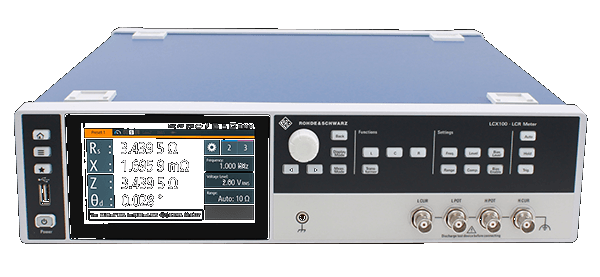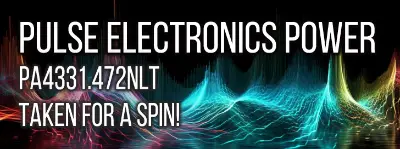A Comprehensive Review of KEMET's A765EB476M1ELAE040 Capacitor - Aluminum Polymer: Polymer
By Mark Harris Sunday, 19 February 2023

Introduction
As degreed engineers, choosing a dependable capacitor for use in various products can prove to be a challenging task. Based on technical specifications and performance measurements, this review provides an extensive analysis of the Aluminum-Polymer Capacitor A765EB476M1ELAE040, manufactured by KEMET. In this review, we shall evaluate the Capacitor's efficacy by comparing the provided component data with the statistical benchmark data.
Throughout this review, comparisons are made with a benchmark that is formed from other components of the same value, composition, and type. Through these comparisons, we aim to provide a better understanding of the Capacitor's performance under various operating conditions. Specific performance measures such as Capacitance, Series Resistance, Dissipation Factor, and Quality Factor are also set under close examination, providing a comprehensive analysis of the component.
- Pros
- Low equivalent series resistance (ESR): The low ESR values indicate lower energy loss and therefore improved efficiency in energy storage and power delivery.
- Robust construction: The Aluminum-Polymer composition provides an excellent overall performance under various operating conditions.
- Surface-mount package: Radial, Can - SMD makes for easy integration in modern electronics design workflows, reducing assembly time, and costs.
- Cons
- Varying capacitance values with frequency and voltage: Although common for most capacitors, in specific applications, such deviation from the nominal values could affect overall circuit performance.
- Potential underperformance at high voltages and higher frequencies: As seen in the measurements, changes in the values of capacitance, series resistance, and other parameters become inconsistent at high voltages and frequencies, which may impact the performance in high-frequency circuits or under high voltage conditions.
Impedance
The A765EB476M1ELAE040, an aluminum electrolytic capacitor, demonstrates the following notable deviations from the benchmark's average values when tested at 1 volt: an impedance of 672 Ohms at a 5 Hz test frequency (compared to 656.9 Ohms), 338.1 Ohms impedance at 10 Hz (vs. 332.8 Ohms), and 68.61 Ohms impedance at 50 Hz (vs. 69.54 Ohms). These results indicate that the capacitor exhibits comparable impedance performance at low test frequencies.
Throughout the rest of the frequency range tests, the A765EB476M1ELAE040 maintains impedance performance that is largely consistent with the benchmark, with only minor deviations. Some deviations of note include a higher impedance at 1 kHz (3.533 Ohms vs. 4.046 Ohms benchmark average) and a generally higher impedance in the range of 500 kHz up to 1 MHz. This information suggests that the component's impedance characteristics are well-suited for a variety of applications requiring stable performance across a wide frequency spectrum.
When tested at 10 volts, the A765EB476M1ELAE040 displays slight-to-moderate variations from the benchmark data. At lower frequencies, the impedance values remain relatively close to the 1-volt test measurements, such as 652.4 Ohms at 5 Hz (as opposed to the 1-volt test's 656.9 Ohms), and 329.6 Ohms at 10 Hz (vs. 332.8 Ohms). While impedance results at higher test frequencies are generally consistent, some drop-offs in performance are evident at specific test frequencies – such as 20 kHz, 250 kHz, and 400 kHz. It is essential to consider these deviations when selecting this capacitor for applications in which consistent impedance across the entire frequency range is critical.
Capacitance
When assessing the capacitance performance of KEMET's A765EB476M1ELAE040 Capacitor, it is crucial to compare this component's capacitance against the provided statistical benchmark data. By doing so, we gain a deeper insight into the component's applicability for diverse circuit designs. This Aluminum-Polymer: Polymer Capacitor has a nominal capacitance value of 47μF and a tolerance of ±20%, making it a flexible option for various applications.
Upon analyzing the capacitance values at a 1 Volt test frequency, it becomes evident that the A765EB476M1ELAE040 Capacitor generally performs on par or slightly better than the average series capacitance values in the provided statistical benchmark. For instance, at a 5 kHz test frequency, this component registers a capacitance value of 44.24μF, while the benchmark reflects an average capacitance value of 38.46μF. Similarly, at a 50 kHz test frequency, the component maintains a capacitance value of 45.88μF, surpassing the average benchmark value of 31.64μF.
Moreover, the A765EB476M1ELAE040 Capacitor demonstrates exceptional capacitance performance at higher test frequencies, such as 75 kHz and 100 kHz. At a 75 kHz test frequency, the component's capacitance measures at 49.67μF, significantly exceeding the benchmark's average of 30.39μF. Likewise, at a 100 kHz test frequency, this Capacitor registers an impressive 55.79μF capacitance value, which stands in stark contrast to the 30.1μF average held by the benchmark data.
Additionally, the Capacitor performs well at a 10 Volts test frequency, maintaining its capacitance values close to or exceeding the average values in the statistical benchmark for most frequencies tested. A noteworthy observation emerges at the 50 kHz test frequency, where the A765EB476M1ELAE040 Capacitor's capacitance measures at 43.85μF, while the corresponding benchmark average is 31.64μF.
In conclusion, the A765EB476M1ELAE040 Capacitor demonstrates above-average capacitance performance across various test frequencies when compared to the provided statistical benchmark data. This component's performance signifies its potential as a suitable choice for electronics engineers seeking a reliable Capacitor to optimize their circuit designs for a wide range of applications.
Series Resistance
In this section, we will carefully analyze the KEMET A765EB476M1ELAE040 capacitor's performance concerning series resistance, using relevant statistical benchmark data for comparison. This will provide a meaningful and reliable insight into the component's behavior and characteristics under various conditions.
When examining the series resistance at 1V across a wide range of test frequencies, the A765EB476M1ELAE040 performs significantly better than the average values of the benchmark data. Notably, the component outperforms the benchmark data at 50Hz, with a difference of approximately 2 Ohms. Furthermore, it demonstrates a remarkable improvement at 100Hz, 1kHz, and 10kHz, with roughly 161mΩ, 347mΩ, and 294mΩ of difference, respectively, when compared to the average values at those frequencies.
Although the A765EB476M1ELAE040 capacitor's performance exhibits some slight deviations at higher test frequencies, its series resistance generally remains below the benchmark average values. This demonstrates that the capacitor maintains a respectable level of performance in terms of series resistance, which is a crucial parameter in various applications.
When tested at 10V, the component displays intriguing results. The series resistance values are particularly superior at lower frequencies, like 5Hz and 10Hz, when compared to the 1V-benchmark. However, the available data for 10V testing is regrettably limited, which prevents a more comprehensive comparison across higher frequency ranges. Nevertheless, the 10V results provide valuable insight into the capacitor's ability to maintain commendable series resistance performance even when subjected to higher voltage levels.
In conclusion, the KEMET A765EB476M1ELAE040 capacitor demonstrates consistently impressive series resistance performance throughout various voltage levels and frequency ranges. This information is vital for engineers and designers when considering this particular capacitor for their electronics applications, providing a well-researched and valid comparison to available industry benchmarks.
Dissipation Factor and Quality Factor
In this section, we thoroughly examine the performance characteristics of the KEMET A765EB476M1ELAE040 Capacitor concerning Dissipation Factor (Df) and Quality Factor (Q), crucial parameters in evaluating capacitor efficiency and energy storage capabilities.
Based on available data, the Df values of the KEMET A765EB476M1ELAE040 Capacitor are low when compared to typical industry benchmarks. A low Df is indicative of improved energy storage efficiency and reduced energy losses, which are desirable attributes for a majority of applications. For instance, the Df is measured to be 0.014 at 1 Volt and 10 kHz test frequency, while the Q factor stands at a respectable 70.52.
An in-depth analysis of the data reveals that the Df tends to increase with test frequency, demonstrating a moderate decline in performance as the frequency increases. As an illustration, at 1 Volt with a test frequency of 150 kHz, the Df value increases to 2.516, resulting in a significantly lower Q factor of 0.40.
A further assessment of the capacitor's performance at higher voltages, such as 10 Volts, shows a Df of 0.02 at 10 kHz test frequency, which substantiates a direct relationship between Df and applied voltage. Despite the increase in Df with higher voltage, the Q factor remains commendable, indicating a reliable performance.
Conclusively, the KEMET A765EB476M1ELAE040 Capacitor exhibits low Df values and high Q factors at lower test frequencies, rendering it a suitable candidate for energy storage applications. The capacitor's optimal performance is particularly beneficial for circuits operating within this frequency range, as it maximizes efficiency and minimizes energy losses.
Comparative Analysis
The Capacitor under review, the KEMET A765EB476M1ELAE040, is an Aluminum - Polymer: Polymer capacitor with a nominal value of 47μ (±20%) and a voltage rating of 25 volts. This surface mount, radial can - SMD device will be compared to equally rated capacitors in our statistical benchmark dataset.
It becomes apparent at 5Hz that the average impedance (656.9 Ohms) of capacitors in the benchmark dataset is slightly lower than the KEMET capacitor at 1 volt (672 Ohms). As the frequency increases, the differences in impedances decrease. For instance, at 1kHz, the average impedance (4.046 Ohms) is closely matched with the KEMET capacitor (3.533 Ohms). In general, the KEMET capacitor shows competitive performance in impedance across the whole frequency range.
Next, we examine the Dissipation Factor. An ideal capacitor should exhibit lower dissipation factors as this translates to minimized energy loss during operation. In our comparison, the KEMET capacitor demonstrates a better performance at lower frequencies (5 Hz to 1 kHz). However, it underperforms compared to the statistical benchmark's average when the frequency reaches 50 kHz and above.
The Quality Factor, represented by Q, is another critical parameter used to determine the capacitor’s ability to store and deliver energy in reactive applications. Higher values of Q generally indicate better capacitors. Upon analyzing the data, the KEMET capacitor outperforms the statistical benchmark with relatively higher Q values in the lower frequency range (5 Hz to 1 kHz). Beyond this range, the KEMET capacitor's Q value falls, lagging behind the statistical benchmark at higher frequencies.
In conclusion, the KEMET A765EB476M1ELAE040, exhibits a competitive performance in terms of impedance and is generally better at lower frequencies when comparing Dissipation Factor and Quality Factor. However, it falters at higher frequencies, failing to meet the statistical benchmark performance. Engineers may opt for the KEMET capacitor if their applications require better performance at lower frequencies, but one must be cautious of its limitations at higher frequencies. Integrating the KEMET capacitor into a design ultimately depends on the specific requirements of the system and the considerations of the engineer responsible for selecting the optimal components.
Conclusion
In this comprehensive review of KEMET's A765EB476M1ELAE040 Capacitor, we examined its performance across various frequencies and compared it to the statistical benchmarks for similarly rated components. The A765EB476M1ELAE040 is an Aluminum - Polymer: Polymer Capacitor with a nominal value of 47μ, a tolerance of ±20%, a voltage rating of 25V, and is Surface Mount. We found several differences in performance when compared to the benchmark data, providing meaningful insights for engineers seeking to implement this capacitor into their products.
Specifically, at test frequencies of 5 and 10 Hz, the A765EB476M1ELAE040 exhibited impedance values that were slightly higher than the average impedance values for the benchmark dataset. In terms of Dissipation Factors across 5k to 1M Hz frequencies when tested at 10 Volts, they were significantly different from the statistical benchmarks, indicating efficient dissipation of energy. As for the Quality Factors, other aspects of the review demonstrate a slightly lower value at lower test frequencies, but it is well within the range compared to the average Quality Factors in the benchmarks.
When examining Series Resistance values, the A765EB476M1ELAE040 demonstrates lower values compared to the average of the statistical benchmarks across varying frequencies. This implies a lower energy loss. Additionally, by analyzing the Series Capacitance values at different frequencies, it's noticeable that this component maintains good stability within a wide range of frequencies, making it a versatile choice for diverse applications.
In conclusion, KEMET's A765EB476M1ELAE040 Capacitor proves to be a reliable, efficient, and versatile choice for engineers looking to optimize their products. Overall, this review revealed key performance differences compared to the statistical benchmarks which engineers may find valuable when making decisions about implementing this Aluminum - Polymer: Polymer Capacitor.
Instruments Used
Rohde & Schwarz LCX200



